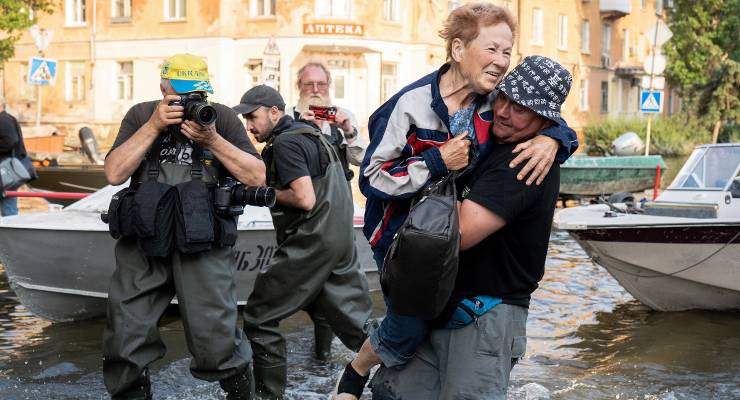
While Australian politics have been squabbling this past week about how to make the war in Ukraine all about us, action on the ground — and in the waters — of the country last week marked a turning point with the destruction of the Kakhovka Dam and Ukrainian President Volodymyr Zelenskyy’s confirmation of social media’s worst kept secret: the beginning of the summer counteroffensive.
Meanwhile, in Ukraine, the country’s political and once-oligarchic elites are discovering an important truth: when you mobilise for a people’s war, the people will have their own demands. The result? A growing shift in power to independent media and civil society that will shape the country’s postwar society.
There’s much we don’t yet know about the collapse of the dam, although as an attack on civilian infrastructure it’s likely to turn out to be the most significant war crime since the invasion began. It is already causing the greatest ecological disaster in Europe since Chernobyl, not just in the flooded areas of southern Ukraine, but across the ecosystem of the Black Sea with Zelenskyy warning of ”sewage, oil, chemicals and possibly anthrax from animal burial sites”. Rubbish from the flooding is already washing up on Black Sea beaches.
The United Nations has reported that about 700,000 people have lost access to drinking water and the UK Defence Intelligence Ukraine update says the collapse has “almost certainly” caused the North Crimea Canal — the main source of water for the occupied peninsula — to run dry.
In The Australian, Alan Howe reached back to the devastating history of dam collapses, particularly in war, including the myth-making “dam buster” air raids on the Möhne and Edersee dams, which flooded the German Ruhr and Eder valleys. The raids were made famous by one of Australia’s biggest-selling journalist-authors, Paul Brickhill, in his 1951 book The Dam Busters, although more recent reporting suggests that the main victims were, as in Ukraine, those living in the dam’s floodpath.
It’s not the first impact of the war on the fragile Black Sea ecology, with the BBC recently reporting thousands of endangered Black Sea dolphins and porpoises killed by “acoustic trauma” as a result of increased Russian naval sonar activity.
The dam collapse was almost certainly caused by Russia — which has controlled the dam since the early days of 2022’s full-scale invasion — either deliberately to disrupt the looming counteroffensive (Zelenskyy warned the dam had been mined back in October and seismic data indicates an explosion occurred), or as a warning, with Ukraine releasing an intercepted recording of a Russian military exchange: “It didn’t go according to plan, and [they did] more than what they planned for.”
The New York Times, which has a 90-year history of bad takes on Ukraine, couldn’t resist turning the uncertainty into the worst of “both-sides”, leading with “Ukraine and Russia blamed each other”.
Most of what we know about the Ukrainian counteroffensive comes from “open-source intelligence” that aggregates data from across the web, including social media. In its weekend update, US think tank the Institute for the Study of War drew on Russian and Ukrainian sources to identify four points of activity along the front line, from Luhansk in the north to western Zaporizhzhia in the south.
Which of these are probes, feints or potential breakthroughs will start to show over the next few weeks? Strategic studies academic Phillips O’Brien wrote in his Substack newsletter this week that the main push will try to drive a wedge between the western and eastern Russian forces: “The Russians understand this and have defended the area with some of their best troops and deepest defensive lines … What we are seeing now is a major effort to weaken this defensive line.”
Behind the battlefront, Ukrainian civil society and independent media are using the passions of the war for democracy and the desire to be a normal European nation to assert an Ukrainian identity freed from the power of the country’s post-Soviet oligarchs.
This week Sevgil Musaieva, editor-in-chief of what’s become the country’s leading independent news site, Ukrainska Pravda, described the war as the country’s third “Maidan moment” following on from the Orange Revolution in 2004 and what Ukrainians call “the Revolution of Dignity” in 2013-14 which both grew out of public protests in the Maidan, or main square, in Kyiv.
One key goal is to ensure the postwar does not allow oligarchs to return to power. Her news site, for example, has generated a stir with its exposure of rich Ukrainians sitting out the war on the French Côte d’Azur in a series called “The Monaco Battalion”.
Publicly shamed, she says, they suddenly reappear in Ukraine with patriotic offerings for the Ukrainian armed forces.
It’s just another indication of how human rights and an end to corruption and oligarchic power are already shaping up as key issues in what Ukrainian civil society hopes will be a postwar election in 2024.








Not a very enlightening discussion, this.
I was enjoying this article until about half way through when the Author decided to pick a side with this:
(This is very similar of the Nord Stream Pipeline explosion, with the West incredulously suggesting Russia blew up its own Pipeline).
Both sides have accused each other, and solid cases can be put forward that the dam collapse could favor either side.
There is also suggestions that the extra water above the dam has caused the Dam structure to break of its own accord.
So far no evidence has been uncovered that points to one side or the other.
Unfortunately the collective MSM in the West has bought into the Western Narrative, and propels anything that Ukraine or its partners suggest, while immediately discounting virtually everything that Russia says. Certainly proof of the old adage – “The First Casualty of War is Truth”
Norwegian and Romanian monitoring stations recorded an earthquake at the dam, consistent with an explosion
https://www.npr.org/2023/06/08/1181078981/seismic-stations-detected-explosion-at-ukrainian-dam
So the explosion’s seismic pattern was uniquely Russian? Did it appear on the seismographic in Cyrillic characters?
Not many dams being blown up in non-occupied territories, for sure.
Maybe the dam was blown up because the territory had been occupied?
If the ‘Who blew up the dam?’ is genuinely in contention, maybe look at the context in which the dam was blown up?
The territory was invaded.
I seem to remember 20 years ago, every disaster that befell Iraq was blamed on the US. And rightly so. Because, even if the Americans did not instigate particular disasters, they were responsible for the invasion that caused those disasters.
You broke it, you own it.
You invade a country, you own the human and environmental disaster that invasion causes. Iraq didn’t ask to be invaded. Ukraine didn’t ask to be invaded.
Yes the context is prime.
Ukrainian armed forces were understood to be mounting a counter attack across the river. Russia has benefited from the broken dam as it lessens the sites available for the counter offensive (and causes disruption to economy of Ukraine). If a tree in front of someone’s home is poisoned it might be a random act of vandalism, OR the improved view might lead an experienced investigator to question the home owner first….
Russian actions don’t show any sign they care for consequences or ownership of any impacts, but as you note, this is Standard Operating Procedure for an invading force.
I can’t construct any scenario where a Russian government sends it’s people to face war crimes charges, and my guess is Russian generals are holding to that.
Some tin foil hat stuff in here. The Russians were in control of the dam right? Seems fair to blame Russia unless they have proof otherwise….prolly will show the same quality of proof they did for not striking civilian buildings with missiles I guess…
“The United Nations has reported that about 700,000 people have lost access to drinking water and the UK Defence Intelligence Ukraine update says the collapse has “almost certainly” caused the North Crimea Canal — the main source of water for the occupied peninsula — to run dry.”
Who gains from this? Russian Crimea without water? Why are the pundits asserting that “almost certainly it was Russia who dun it?”
Peter, we are fighting the Goliath of Lies and Propaganda. I’m so glad that you are on the side of reason. I welcome you to the brotherhood of ‘Thinkers, not sheep’.
No, you are propagating the Russia’s lied and propaganda. There is no reason on that side.
Totally agree that the propaganda war is aimed at non-logical, non-thinking sheep, namely the majority of Australians. Sadly, the majority of my fellow Queenslanders take a rag like the Courier Mail as their source. OMG. I am with you Peter, and with “doubting thomas”. Every invasion by the US has been based on lies. Ukraine is no different. BRICS may hopefully see the final death rattle of the US war machine. Live in hope, as their society collapses.
The Russians do not care about anyone, even their own – they have refused to evacuate Ukrainians in their occupied zone.
They also have 3 rows of troops, the ones behind in place to shoot those ahead who try to fall back.
Yes, the Russians almost certainly did it.
Man, you’re not heavily into informed knowledge, are you?
Russia took ownership of the dam. If they weren’t able to look after it, they shouldn’t have taken ownership of it.
The ABC broadcast pro Ukrainian propaganda every night .. regardless of where your loyalties and/or opinions reside.. its shameful to the broadcasters reputation..
Agreed.